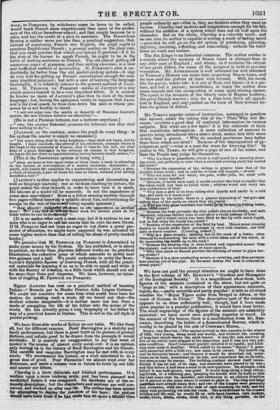We have not paid the prompt attention we ought to
have done- to the first volume of Mr. BENNETT'S. " Grardens and Menagerie of the Zoological Society:' It is a magnificent show-book, with ures of the animals contained in the show, but not quite so arge as life," with a description of their appearance, manners, habits, &c.—partly scientific and partly. popular : it tells us all about whether the "Royal Tigers come from Bengal in Africa, or the coast of Guinea in China." The descriptive part of the animals appears to us done sufficiently well ; though, had it been made more popular in a popular publication, it would have been better. The wood engravings of the figures of the animals are admirably executed we have never seen anything superior in wood. . In the account of the beaver, there is a contribution from Mr. Brio- DERIP, describing the habits of a domesticated Beaver, which is worthy to be placed by the side of COWPER'S Hares, ..
Btuiqr, mmillsavita.---The animal arrived in this country in the winter of 1825, very young, being small and woolly, and without the covering of long hair which marks the adult beaver. It was the sole survivor -of five or six which were shipped at the same time, and it was in very piti- able condition. Good treatment iquickly restored it to health, and kind- ness soon Made it familiar. When called by its name "Binny," it gene- rally answered with a little cry, and came to its owner. The hearth-rug its ts favourite haunt ; and thereon it would lie stretched . out, smile- times on its back, sometimes on its side, and sometimes fiat on its belly, but always near its master. The building.instirict showed -itself imme- diately it was let out of its cage, and materials were placed in its way; and this before it had been a week in its new quarters.' Its: strength, even before it was half-grown, was great. It would drag along a large sweep- ing-.brush, or a warming-pan, grasping the handle with its teeth so that the load came- over its shoulder, and advancing in an oblique' direction till-it arrived at the point where it wished to place it. The long-and large law:Okla were.always taken first; and two of-the longest were geneinily laid crosswise, with one of the ends of each touching the-wall, and the other ends projecting out into the .1"00111. The area-formed by the crested bruilies add the wall, he would fill up with 'and brpslairs, riish .baskets, beak -boots, sticks, cloths, driedturf, or any thing -portable. As the
, , . , .
CL
-art:irk grewhigh, he Oupported himself cfn his teil, which propped him up ,adinirably, and he would often,,afterlaying on one of his building mate- rials, tit up over against it, appearing to consider his work, or, as the cotattry.people say, "judge it." This pause was sometimes followed by 'changing the position of the material "judged," and sometimes it was left in its place. After he had piled up his materials in one part of the • room (for he generally chose the same place), he proceeded to wall up 'the space between the feet of a chest of drawers which stood, at a little distance from it, high enough on its legs to make the bottom a roof for him ; using for this purpose dried turf and sticks, which he laid very even, and filling up the interstices with bits of coal, hay, cloth, or any thing he could pick up. This last place he seemed to appropriate for his dwelling ; the former work seemed to be intended for a dam. When he had walled up the space between the feet of the chest of drawers, he proceeded to carry in sticks, cloths, hay, cotton, and to make a nest; and when he had done, he would sit up under the drawers, and comb himself with the nails of his hind feet. In this operation, that which appeared at first to be a male formation was shown to be a beauti- ful adaptation to the necessities of the animal. The huge webbed hind feet of the beaver turn in so as to give the appearance of deformity ; but if the toes were straight, instead of being incurved, the animal could not use them for the purpose of keeping its fur in order, and cleansing it from dirt and moisture. Binny eenerally carried small and light articles between his right fore leg and his chin, walking on the other three legs ; and large masses, which he could not grasp readily with his teeth, he pushed forwards, leaning against them with his right fore-paw and his chin. He never carried any thing on his tail, which he liked to dip in water, but he was not fond of plunging in the whole of his body. If his tail was kept moist, he never cared to drink ; but if it was kept dry, it be- came hot, and the animal appeared distressed, and would drink a great deal: It is not impossible that the tail may have the power of absorbing water, like the skin of frogs ; though it must be owned that the scaly in- tegument which invests that member has not much of the character which generally belongs to absorbing surfaces. Bread, and bread and milk and sugar, formed the principal part of Binny's food ; but he was very fond of succulent fruits and roots. He was a most entertaining creature ; and some highly comic scenes occurred between the 'worthy, but slow beaver, and a light and airy macauco that was kept n the same apart- ment.—Bennett's Zoological Gardens.



























 Previous page
Previous page